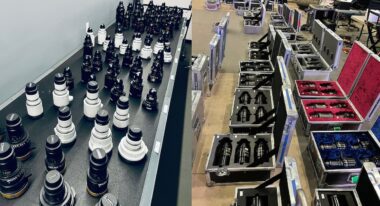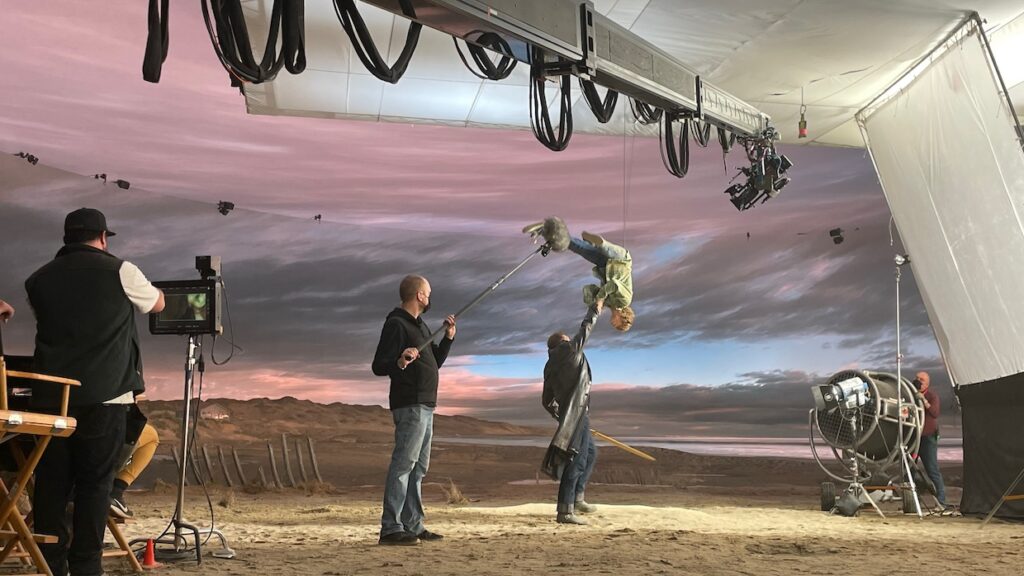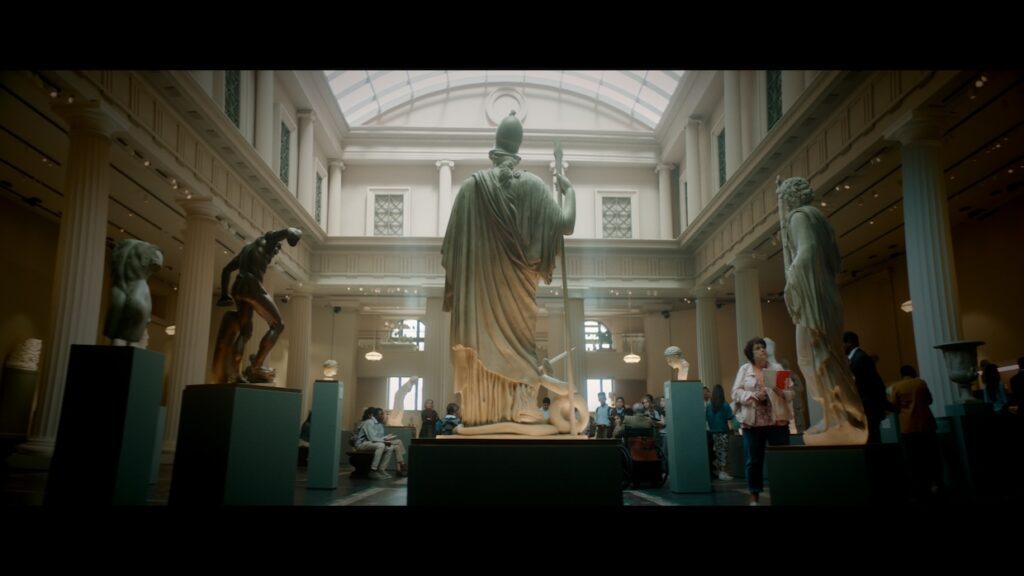 Back to selection
Back to selection
Shutter Angles
Conversations with DPs, directors and below-the-line crew by Matt Mulcahey
Shooting in ILM’s New StageCraft Volume Virtual Production Facility: DP Pierre Gill on Percy Jackson and the Olympians
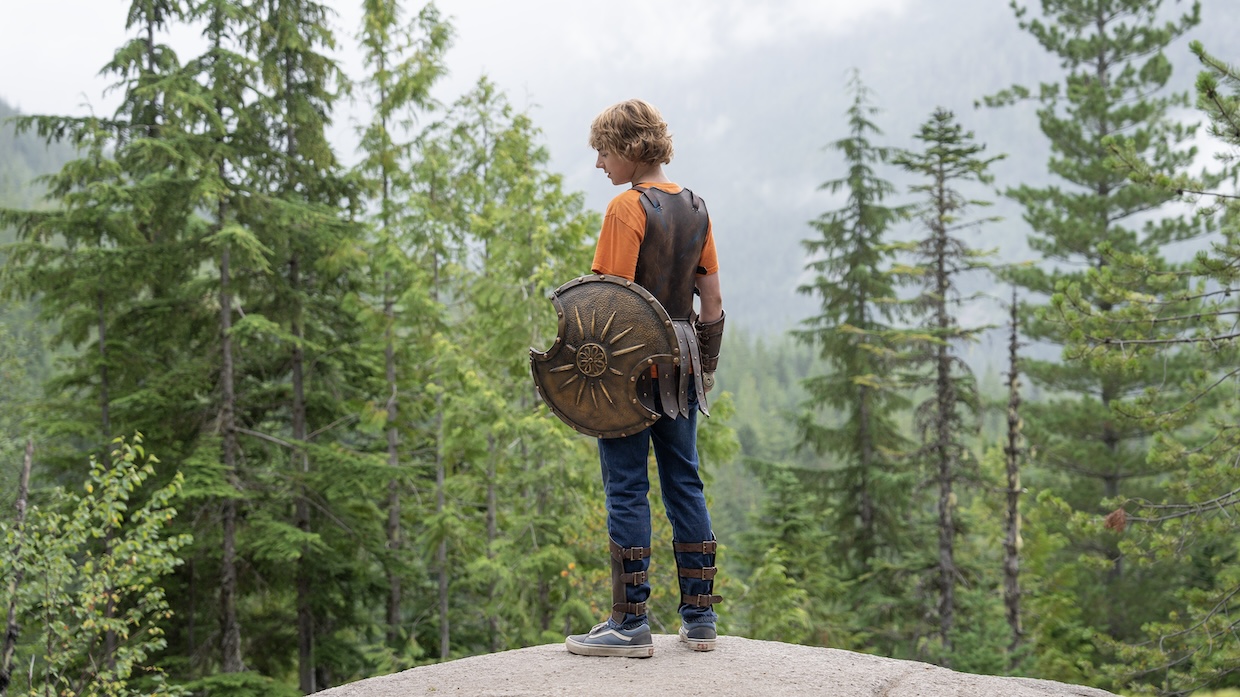 Walter Scobell in Percy Jackson and the Olympians
Walter Scobell in Percy Jackson and the Olympians In the first season of Disney+’s Percy Jackson and the Olympians, the titular teenaged demigod and his compatriots travel across the country, with stops from St. Louis to Las Vegas, on a mission to prevent war among the Greek gods.
However, cinematographer Pierre Gill and his crew never left the vicinity of Vancouver. Percy Jackson is the first show to use Industrial Light & Magic’s new 20,000-square-foot StageCraft Volume in the Canadian city. Gill estimates 30 percent of his episodes were shot in the virtual production environment on its 95-foot LED wall.
With the show now streaming in its entirety on Disney+, Gill spoke to Filmmaker about mastering the volume and testing more than 50 lenses before finding the perfect fit.
Filmmaker: I have to start by asking about these epic lens tests you did for Percy Jackson. You looked at 50 sets. I don’t even think I could name 50 sets of lenses off the top of my head. Did you go in with a well-defined list of everything you wanted to look at or were you just grabbing things off the shelves at [Canadian rental house] William F. White?
Gill: Well, [the team at] White knows me a bit and know how much I care about lenses. So, they chose a bunch of lenses for me to look at, then I also had some specific ones I wanted to try. They brought all kinds of things out for me—funky lenses, clean lenses. I wanted to test spherical. I wanted to test anamorphic— 2x, 1.8x and 1.3x. We tested Arri. We tested Panavision. It was a lot.
Filmmaker: At that point were you still considering spherical or large format?
Gill: I tested the Alexa 65 with spherical lenses. It was gorgeous, but there was a problem. We did our tests on the Volume and there was something about the bokeh with the 65 on spherical lenses where I was like, “Oh, that’s not going to work at all,” because it made the background look closer [the opposite of the effect Gill was after]. What I was trying to find was a lens that was going to be as smooth and soft and natural as possible, but also give me that depth. So, I decided I wanted to work with anamorphic. Ultimately, we shot on the Sony Venice 2, which is very sharp, but when I found the Cooke/i S35 2x anamorphic lenses and put them on the Venice, it was like, “Ah, this is nice.” It was crisp but not sharp, because I don’t like sharp. The eyes were beautiful, and the skin was nice but not too sharp. It was just velvety. I didn’t need any filters. Usually, I put filters on all the time with digital. I always use a filter to just blend things together, make it more of a film look with a diffusion filter. So, that was a great thing. No diffusion filter in front of the lens for the whole shoot.
The 2x anamorphic was also much nicer than the 1.8x anamorphic. The difference is quite big, and I felt it and fought for it. After we shot our tests, I went into [the post house] and compared everything on TV screens, and also on big screens. I got the colorist and other people from post and said, “I’m going to show you four shots. Tell me which one is the best,” and everybody chose the combination of the Venice and the Cookes. The Venice is a great tool too, because you get the [option of using] the Rialto [Extension System]. I had my operator with these big Cookes on that little thing handheld. Also, the thing about the Venice [and its dual base ISO] is you can jump from 800 to 3,200 ISO and it doesn’t even show, which is really useful.
Filmmaker: The Venice 2 came out not long before you shot the first season of Percy Jackson.
Gill: Yeah, I was the first one to get them in Canada.
Filmmaker: In that testing process, were the Cookes, like, the third lens set you looked at or, like, the 49th?
Gill: They came in pretty quickly. I know the Cookes well. I’ve shot with the S4s and S5s. The glass is beautiful and it’s a bit warmer and good for skin. There was one problem: The flare from the Cookes made a red dot that went in front of the actors’ faces. So, I told [William F.] White, “I want to use these lenses, but I don’t think I can, because this flare will cause me problems. Can you do something?” And these are huge, monumental lenses, but they opened them up, one by one, and figured out how to reduce the flare. [Senior optical technician] Alex Theodore literally spent a thousand hours on that. To do one lens, it took him, like, three days, because he had to take off the glass, move [pieces around], put it back together, put it on the bench and make sure the lens was still okay, then put a light through only to see “Oh, it doesn’t work.” Then you have to try it again and again. He started with the 40mm and the 75mm and when I said, “Yeah, it’s going to work. I love that bloom we’re getting,” then he worked on the rest of the series.
Filmmaker: And you had four sets of lenses that had to be done too with like eight to ten focal lengths per set. So, it’s a lot of work.
Gill: Right, it was a lot. I asked him to do one set that I called the PG Velvets because they had a nice, very velvety quality. Then I said, “Give me a set that’s the opposite and I’m going to call them the PG Extremes, then make me a set that exaggerates the flare a little bit if I want to use that sometimes.”
Filmmaker: How long did the testing last?
Gill: I spent three days testing inside the Volume. White’s was super cool, because they brought me into Toronto where they had the huge Volume they use for the Star Trek shows and got every technician to come in for me on a weekend to test. I had all the cameras, all those lenses and I could test them with the Volume screen. If you’re not testing them on the Volume for a show like this, there’s no point.
Filmmaker: What did you put on the walls for the tests?
Gill: They gave me the Star Trek backgrounds.
Filmmaker: Percy Jackson’s quest in the show takes him all over the United States. It essentially becomes almost a road trip show for some of the season. Did you shoot almost everything in and around Vancouver and then on the Volume?
Gill: We shot everything around the Vancouver area, on a stage or on the Volume. The only other shots you will see are the typical establishing shots of New York over the bridge, but everything else is all in Vancouver. On my episodes, at least 30 percent of the work was done on the Volume as well. In the first episode, all the interiors and exteriors for the Metropolitan Museum of Art in New York were all Volume. All the minotaur fight sequence was on the Volume. There was a lot.
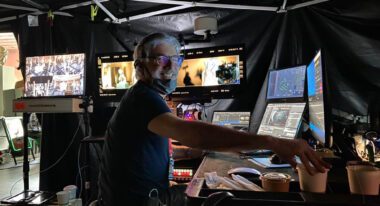
Filmmaker: I’ve read that you have a unique on-set color process. Walk me through that.
Gill: First, I create my own LUT during testing, which other DPs do as well. Then, when we’re shooting, I’m creating Color Decision Lists (CDL) to go over that LUT all the time to match the cameras. For example, on this show I had actors with more magenta skin and others with more cyan skin. So, what I do right way is go into my gamma and tweak. It makes the shots look better, it makes the editing look better because the shots all match and it saves a lot of work. There’s no colorist who has to do that matching at night, which people don’t really do anymore. You might have someone clean up the dailies with a very fast pass. [With my process] every shot of every scene is matched perfectly. It’s been something that most of the directors I’ve worked with have praised, and producers love it too. It also becomes a guide for post.
Filmmaker: Is the DIT making these changes with your guidance or are you physically sitting there making the changes yourself?
Gill: I do it myself for all the cameras on every shot. I have my Livegrade setup and play very quickly just in the highlights, mids and blacks. I’m not doing secondaries or anything like that, just the basic contrast, brightness and gamma. My DIT loved that process as well. On the episodes I didn’t shoot, he took over control. We’d have the CDLs saved so if they were shooting a scene or a location [we’ve done already], they could apply them.
Filmmaker: How did you create the effect for the character of Chiron, a centaur whose human half is played by Glynn Turman?
Gill: There are many ways to do those types of effects. For some of the wide shots, we had [Turman] actually on the back of a real horse, then had to replace the center of the horse’s body in post [since Turman’s legs while riding cover that portion], but on a wide shot that’s pretty simple. The tricky part was the eyelines. Percy had to look at the head of the horse and not at Chiron, and Chiron had to look next to him and not at Percy. So, both actors were looking at no one all the time.
Filmmaker: There’s a Volume-shot scene where Chiron and Dionysus [played by Jason Mantzoukas] are talking to Percy at Camp Half-Blood. How did you handle that one? Did you try to put a horse in the middle of the Volume?
Gill: For that one, [Turman] was just walking on boxes with blue pants on. Then we shot plates with the horse on blue screen and tried to recreate the lighting as best as possible, then they comp them together.
Filmmaker: In the final episode, there’s a showdown between Percy and one of the gods on a beach at magic hour. It’s an example of where the Volume can be so advantageous, because you have an infinite amount of dusk to work with instead of a 20-minute window before you lose the light. In this behind the scenes shot above, what is that big rag you see over the actors’ heads? Is that diffusing the light from the LED ceiling panels of the Volume, or do you have our own units in there and it’s basically a soft box?
Gill: It’s a giant soft box with SkyPanel S60s and very, very thick triple diffusion—Muslin plus silk plus another layer. I learned so much about the Volume working on this show. The ceiling doesn’t have the same quality panels [as the rest of the Volume]. They are 5mm [pixel pitch] and the walls are 2.2mm. The problem with the 5mm is that they’re bigger and RGB so it’s like green, blue and red and then one side [of the pixel] throws green and the other side might throw magenta, and it really shows. When you use the ceiling as a light, it’s very hard for color balance. It’s not nice for faces.
Filmmaker: Are those Arri Orbiters I see in the photo? What did you use those for?
Gill: Yeah, I was hitting Percy with them very, very softly to create a little highlight of the sun. At first, that scene was supposed to be at night, and I said to the producer, “Please don’t do that. Night doesn’t really work well in a Volume, because the walls don’t want to see black. It’s not made for black.” So, we changed it to a day scene, then I was like, “Okay, let’s go with dusk.” We tested four or five different types of sand to see what color was best. All these pieces of wood, I got the production designer to bring them in and start testing them with the Volume, then you start saying, “They’re too warm. Let’s paint them grayer.” I asked ILM to have a sky that was stormy on one side for this scene. I also got ILM to create tools for me that allowed me to control the sky and the sun myself. I was always asking them, “Can you flip it? Can you turn it? Can it go this way?” You have to cheat the sky every time you do a shot. If I do a close-up of the actor and it is just grey behind them, it’s boring. So, I have to switch it around so that maybe there’s this little cloud sticking out of the horizon behind him. [Virtual production supervisor] Sonia Contreras, who was brilliant and amazing, got one of her engineers to build me a sun control on a Tangent Element Kb panel. Now I had two knobs I could adjust—one for my Livegrade, one that let me flip the sun and clouds myself. That allowed me to change the ratio of contrast myself.
Filmmaker: To me, one of the things that really made that scene pop was the puddles of water on the beach and the reflections of the sky in them. It helps to blend the practical elements with the Volume elements.
Gill: Yes, the Volume loves reflections. For the scene at the Met [in episode one], I even asked the costume designer to make sure that Mrs. Dodds [played by Megan Mullally], who is the first monster we see, had a shiny, black leather coat so it would pick up the color of the Volume.
Filmmaker: You said ILM gave you control over adjusting certain aspects of the wall. I talked with Star Trek: Strange New Worlds DP Benji Bakshi and he told me that for that show’s second season, they could now basically assign individual virtual light sources to the physical dimmer to be controlled alongside the practical lights. Did you have that ability on Percy Jackson as well? For example, in that Met scene could you raise or lower the level of the wall sconces around the exhibits?
Gill: Yes, I had control of those lights. I had control of the skylight as well. I even changed the perspective of that shot. I cheated the ceiling and squished it down. It’s quite complex, to be honest with you. It’s unbelievable, the amount of detail. We relit [the LED wall plates] for the whole interior Met, because originally they were just 3D scans from the real Met. There was an artist that worked with me for the contrast, the color, the bounce back from the sky. So, I could be at least closer to what I wanted when I got there on set. The interior Met was all done in camera. There is no VFX touch up. It’s full-on live and I think it looks pretty good.
